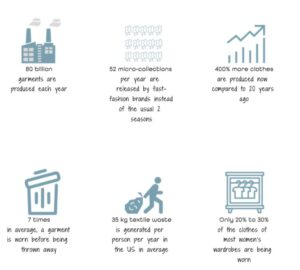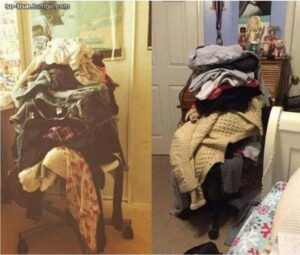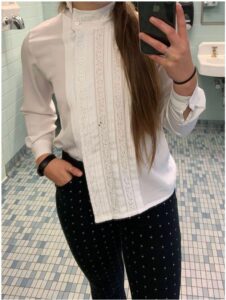![]()
Author: Laura Evans

Infographic via SustainYourStyle
At the start of this month, the Environhawks delved into the world of fast fashion and how harmful it can be to both people and the environment. Overconsumption continually feeds the demand for both cheap labor and overproduction. Not only that, but garment production proves costly in terms of natural resources like oil and water. For example, “[n]early 70 million barrels of oil are used each year to make the world’s polyester fiber, which is now the most
commonly used fiber in our clothing. But it takes more than 200 years to decompose.” (Conca, 2015). High levels of cheap, resource-demanding clothing being discarded directly into landfills where they do not decompose account for horrendous levels of water pollution, environmental pollution, and serious human rights violations in labor. If you’re a newcomer to sustainable living, vetting the clothing industry in search of an ethical source of clothing can be both
intimidating and demoralizing. Today, I’ll be presenting ideas for where to get started on your journey to building a more sustainable wardrobe. Remember, it’s an ongoing process, not an overnight change.

The ocean has become the proverbial laundry chair of the world’s discarded clothing. However, it may prove a bit more difficult to clean up. Image via Ranker
“Typically, for a garment to be considered ‘sustainable,’ it should be eco-friendly, ethically made, lasting, and accessible” (Costello, 2020).
Preparation Is Key
Now, it may seem impossible to meet these “garment goals,” but a little forethought can go a long way. First, take your time and decide what statements you want your clothes to make: colorful or neutral? Textured or austere? Second, consider what pieces you need for your work environment or lifestyle. Blazers and slacks? Breathable athletic wear? Next, research “‘fit inspiration.” Rather than letting items choose you (think targeted facebook ads!), find clothes that speak to you.

I keep an ongoing list (and Pinterest board) of items I’d like to buy if I found them for a good deal. Rather than following the link from an ad or searching for an item on amazon, I play a waiting game. For instance, I had been searching for a pair of burgundy red jeans since I wore out the pair I had in high school. Finally, last year I found a pair in the thrift shop that matched my demands: the color, the stretchiness, the size.

This brings me to the moment you’ve been waiting for: a purchase. Even with all your preparation, it’s important to take a moment before you buy. Think to yourself, “Is this piece functional? What can I wear this with? Do I really like this? Will I wear it often, or is it a one-event wear?” If you can “justify” your purchase, then the garment will likely serve you well
for a long time.
A Matter of Contention
Thrifting is my favorite way to shop sustainably, but before I get to local recommendations, I want to address several valid points of criticism . Perhaps a thought bothered you the back of your head when I said I waited several years to find a pair of red pants: not everyone has time to wait that long; not everyone has time to go thrift shopping, period. It can be a time consuming process and typically requires filtering through an entire store’s inventory only to come out with 2 to 3 pieces. The process of going to a thrift store (or multiple thrift stores!) also requires mobility. Level of ableness can determine whether or not sustainable shopping is an option for some. Additionally, the availability of sizes varies
dramatically, with “average” body type sizes dominating the selection. In short, a thrift shop rack often lacks inclusivity. It’s important to recognize sustainable shopping for everyone looks different, and resist the temptation to play gatekeeper when you notice someone has purchased fast fashion. Instead, continuing to invite people to the table no matter where they are in their journey toward sustainability is the best method to grow the sustainable fashion movement.
Local Places to Go B(u)y
Hold up–I’m not promoting buying anything you don’t need! However, if you’re searching for cheap clothing options there are several options in town. There are several consignment shops to check out like Revival, The Second Act, and The Savvy Boutique. However, my personal favorites are Goodwill and Artifacts. There are two Goodwill’s: one in Iowa City, one in Coralville. At the Iowa City Goodwill, I’ve found several quality items including a nice oversized suit jacket, and gray peacoat.

At the Coralville Goodwill, I’ve found good athletic wear and belts. Goodwill prices generally cost less than $5 per item, which can’t be beat in my book! I find accessories like belts or jewelry can refresh your look without needing to buy new clothing.

Artifacts is an antique shop that also sells recycled vintage clothing. The cost is more in the $20-30 range, and I found this lovely white blouse (pictured below) for about $25 dollars at Artifacts. I’d been looking for a shirt similar to this for a dance performance, so when I found it, it fit my criteria of being an item I was searching for.

A Final Note:
I wish you well with your sustainable wardrobe journey. Feel free to comment below with your favorite local consignment store, or what your “wardrobe staples” are. If you have favorite blogs, youtube channels, or ethic fashion directories like this one, comment those as well! Thanks for reading, and be looking forward to our local business spotlight at the end of the month!
References
Conca, James. “Making Climate Change Fashionable – The Garment Industry Takes On Global
Warming.” Forbes, Forbes, 3 Dec. 2015,
https://www.forbes.com/sites/jamesconca/2015/12/03/making-climate-change-fashionabl
e-the-garment-industry-takes-on-global-warming/?sh=4848c23079e4.
Costello, Natalie Kay. “What Is Sustainable Fashion? | An Easy Guide for Beginners —
Sustainably Chic.” Sustainably Chic, Sustainably Chic, 18 Jan. 2020,
https://www.sustainably-chic.com/blog/an-easy-guide-to-sustainable-fashion-what-it-is-w
hat-to-look-for-where-to-find-it.